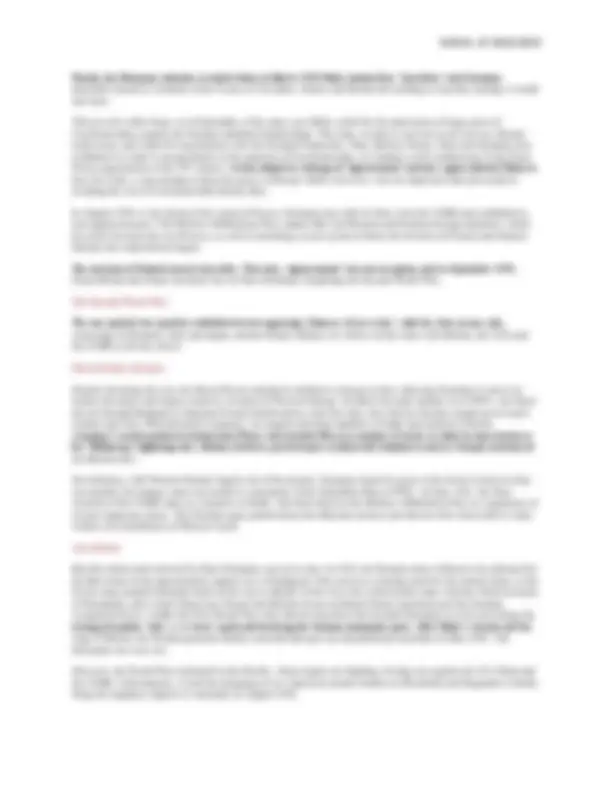




Study with the several resources on Docsity

Earn points by helping other students or get them with a premium plan


Prepare for your exams
Study with the several resources on Docsity

Earn points to download
Earn points by helping other students or get them with a premium plan
Community
Ask the community for help and clear up your study doubts
Discover the best universities in your country according to Docsity users
Free resources
Download our free guides on studying techniques, anxiety management strategies, and thesis advice from Docsity tutors
LECTURE 2 SUMMARY OF "History of International Relations"
Typology: Summaries
1 / 4

This page cannot be seen from the preview
Don't miss anything!



The European Great Powers are perhaps best known for their sprawling colonial empires, having dominated most of the world in the name of imperialism. This colonization process can be tracked back for many centuries, however it was most prominent in the 19th^ and early 20th^ century as a result of industrialization. Benefits What made colonies so important to the Great Powers can be separated into two categories. Firstly, we see the material benefits the colonizers reap. These include resources such as raw materials, commodities and foodstuffs, as well as a vast supply of manpower to serve as both labor or, in the case of war, as soldiers. These resources have the added benefit of promoting trade between the colonies and the metropolis, as well as helping establish a state of autarky, that is, self-sustainability. This helps protect the empire in times of economic hardship or large-scale war. Indeed, it was largely due to their vast overseas empires that Britain and France managed to outlast the Central Powers in the First World War. Secondly, there are also non-material benefits of becoming a colonial power, namely a strong influence on world affairs as well as a level of prestige among the other Great Powers. The concept of ‘Weltpolitik’ discussed in the previous lecture links colonial power to a nation’s status as a Great Power in the first place. Governance Given how large colonial empires became by the start of the 20th^ century, it is no surprise that the system of colonial governance became more complex as well. There are three general methods through which the Great Powers ruled their colonies. The most obvious form of control was of course a direct rule over a colony, meaning national and regional governance was exclusively in the hands of the metropolitan Power. This method was predominantly used in African colonies where local leaders were deemed too ‘traditional’ and incapable of reliable self-rule. Secondly, colonies such as India (under the British Empire) operated under a system of indirect rule where regional matters were allocated to local leaders while the Great Power held a more indirect form of power and dealt only with larger, national issues. These colonies became known as ‘protectorates’. Finally, some colonies were provided with complete self-governance, though still having strong ties to the mainland. These included Canada and South Africa’s status towards Great Britain. These colonies are thus known as ‘dominions’ and operate independently from the metropolis. The problem with this complex system of governance was that it became overly confusing and inefficient, with sometimes all three methods of ruling being found within the same general region, as was the case with Malaya. Additionally, as will be seen later, this gradual shift towards self-governance raised expectations towards ever greater independence from the colonizer. Modernization In order to maximize the benefits attained from their colonies, in the 20th^ century the Great Powers embarked on a process of modernization. This took the form of a two-fold change for colonies, namely higher taxes to pay for the large-scale development, and an enhanced role for the indigenous populations in managing local and regional affairs. This in turn eventually led to systems of representative government at all but the national level, and an increase in education for the local population. This proved to be a self-destructive strategy, as there was now a growing group of knowledgeable locals with a hunger for greater independence. The resultant wave of nationalism called for representation at the national level, threatening to destroy the hold the Great Powers had over many of their
colonies. Calls for self-determination were also motivated by Woodrow Wilson’s fourteen points as discussed in the previous lecture. Other Threats Of course, this was by far not the only danger to the stability of the colonial empires in the early 20th^ century. The First World War taxed the colonies greatly in terms of both resources and manpower, as the Great Powers struggled to remain standing in the drawn-out conflict. With the European states severely weakened, their already strained grip on their overseas territories started to falter. The fate of Germany’s former colonies was another issue. While officially under the mandate of the League of Nations, in practice they were simply absorbed into the French and British Empires, all promises of self-determination quickly forgotten. Naturally, this was seen as highly unfair by the locals and lead to increased tensions. The communist ‘ComIntern’ movement initiated by Soviet Russia promoted an agenda of anti-imperialism and called for a change in the accepted world order. Many communist parties in colonial regions such as China and Vietnam took this to heart and promoted the rise of nationalism and self-determination against the European imperialists. Finally, the rise of Japan as a non-European power stirred a sense of nationalism in many colonies. Here was a non-European nation that had defeated a Great Power, refuting the myth of an invincible western ‘superior’ race. All these factors combined gradually began destabilizing the global colonial order, though it was not until after the Second World War than it disintegrated completely. The Inter-War Year After the Rhineland Pact discussed in the previous lecture, things seemed to be going well again for Europe, with the “Spirit of Locarno” promising economic recovery and peace. However, this was not to last. Ideologies The underlying hostilities between the various new and competing ideologies made a lasting peace impossible. The rise of Nazism in Germany and Fascism in Italy clashed with the liberal democracy advocated by the ‘status quo’ Great Powers of Britain and France. Additionally, the rise and spread of communism in the east was seen as a threat by all of Western Europe. The Great Depression With the rise of these new ideologies came an attitude of ‘anti-establishment’ and revisionism, calling for a change in the world order. This movement thrived on the suffering caused by the Great Depression of the 1930s, as the existing economic structure of trade collapsed. Britain and France sought policies of protectionism, protecting their own economies at the expense of one another, while the totalitarian Powers of Central Europe attempted to achieve autarky. It was seen as a failure of the capitalism system, and thus heralded the rise of a new world order. The League of Nations The organization which seemed so full of potential to bring peace proved ineffective as well. This resulted from a number of fundamental flaws in the system, such as how war was to be prevented with the threat of more war. Additionally, while the League of Nations officially recognized all states as equal, in reality, the Great Powers were in fact the true decision-makers, making it little more than another Concert of Europe with slightly different actors (see Lecture 1 on Concert). Finally, there was no true binding obligation for states to obey policies set forth by the League, so the organization was entirely dependent on inter-state relations and had no power to enforce order. Escalation
Post-War Discussion Even before the War came to an official close, Churchill, Roosevelt and Stalin representing Britain, the USA and the USSR respectively, met in Yalta in February 1945. The ‘Big Three’ discussed a number of items in regard to the post-war world order. One such item was the establishment of the United Nations as a replacement for the obsolete League of Nations. This time around, the problem of Great Power dominance was resolved with the formation of both a General Assembly for all nations and a Security Council consisting of the most prominent Powers. This dual system, along with many other changes, would make the new organization far more capable in ensuring peace. Secondly, the three Powers signed the “Declaration on a Liberated Europe”, allowing all liberated nations to decided their own future in regards to governance. This call to self-determination served the liberal Powers by creating a ‘buffer zone’ of independent states between the distrusted Soviet Union and the democratic Central and Western Europe. Stalin, however, saw this as an opportunity to further Soviet control by legal means, as the Red Army still occupied many of the eastern European states and thus gave him a strong influence on this process of ‘self-determination’. Finally, another issue on the agenda was the borders of the liberated Poland. In light of the territory promised the USSR through the Molotov-Ribbentrop Pact and the soviet military occupation of the region, Poland was ‘shifted’ westward, at the expense of Germany and to the benefit of the USSR.